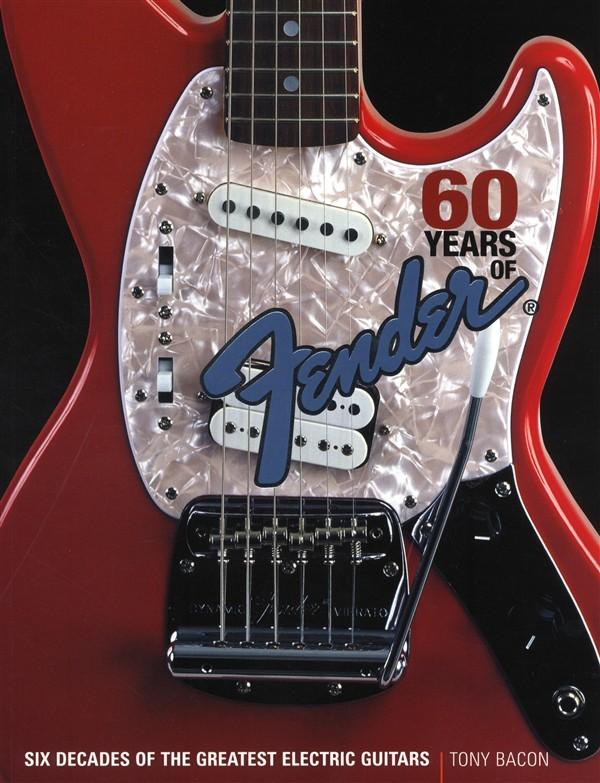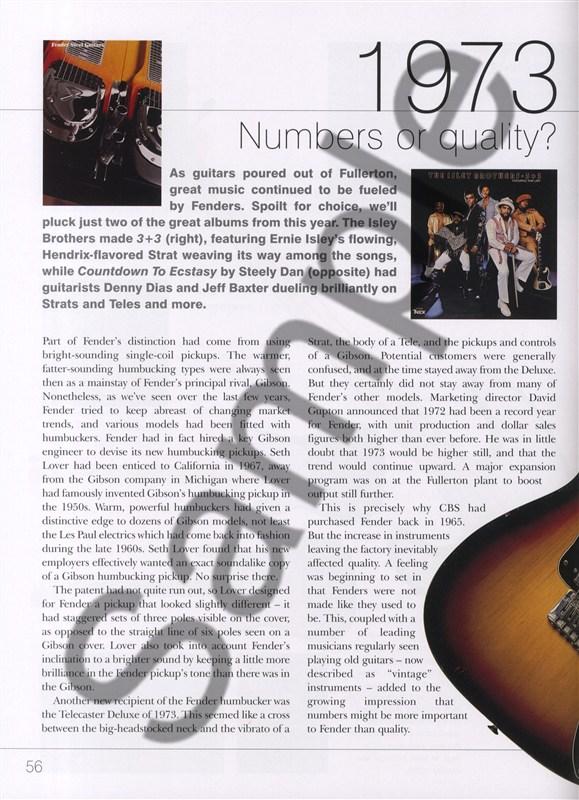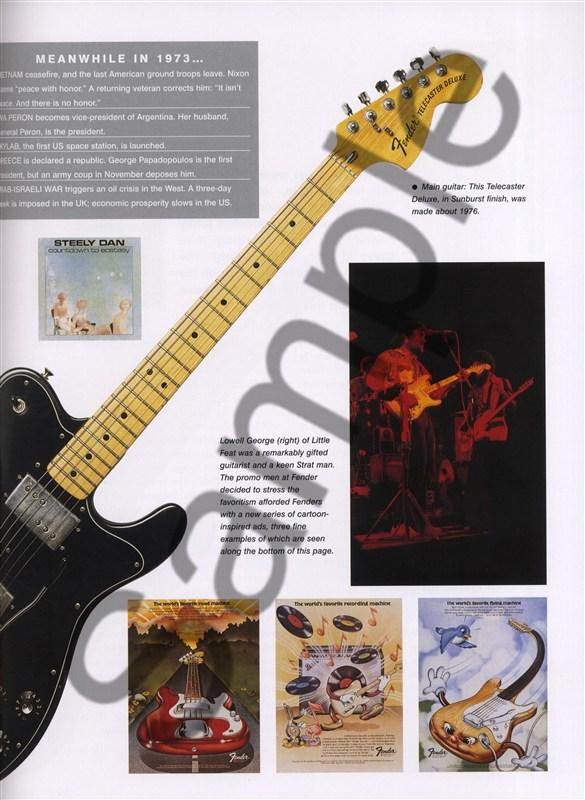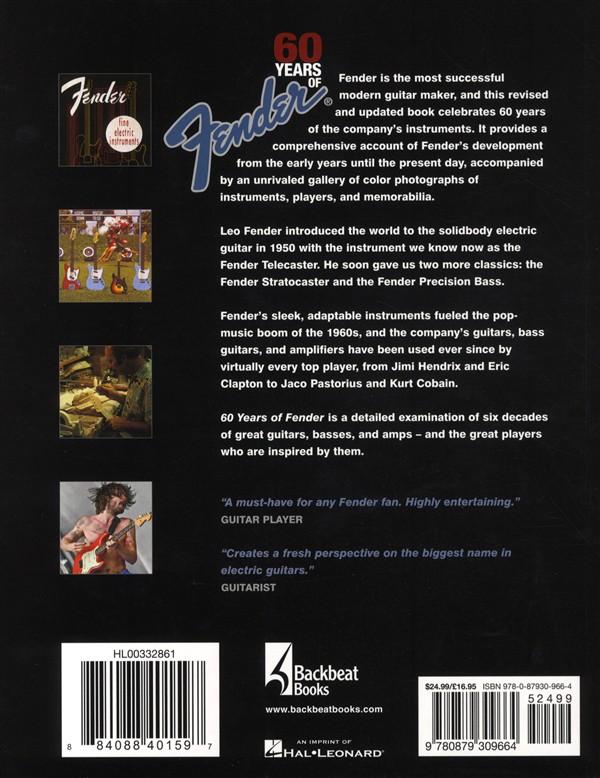FENDER 60 YEARS OF SIX DECADES OF THE GREATEST ELECTRIC GUITARS Tony Bacon STRATOCASTER-TELECASTER
60 Years of Fender Six Decades of the Greatest Electric Guitars. Tony Bacon
Series: Book
Publisher: Backbeat Books
Format: Softcover
Author: Tony Bacon
The latest addition to Tony Bacon's acclaimed series of guitar books, 60 Years of Fender gives a year-by-year history of the most successful electric guitar maker. In 1950, Leo Fender introduced to the world the solidbody electric guitar – the instrument known as the Telecaster. He soon added two more classics: the Precision Bass (1951) and the Stratocaster (1954). Fender's sleek, adaptable guitars have since fueled modern music – from country to rock – and have been heard in the hands of virtually every guitarist of note, from Buddy Holly to Kurt Cobain, from Eric Clapton to John Mayer. Illustrated with an unrivaled gallery of color photographs of instruments, players, and memorabilia, this revised and updated edition expands upon 50 Years of Fender (published in 2000), covering nine more years of the Fender story.
“A must-have for any Fender fan. Highly entertaining.”
– Guitar Player
Inventory #HL 00332861
ISBN: 9780879309664
UPC: 884088401597
Width: 8.5"
Length: 11.0"
144 pages
Leo Fender listened hard to players' comments about the
Telecaster and Esquire models, and during the early 1950s he and
Freddie Tavares began to devise the guitar that would become the
Stratocaster (seen in stylized form on the 1954 catalog cover,
right). At first other makers had merely mocked Fender's new
solid body guitars, but soon Gibson had joined in with its Les
Paul, Gretsch with the Duo Jet, Kay with its K-125. Competition
was looming - and Fender needed to up the stakes. This they
most certainly did.
The Stratocaster was launched during 1954. Samples
around May and June were followed by the first proper
production run in October. The new Fender guitar was
the first solidbody electric with three pickups, meaning
a range of fresh tones, and featured a new-design
vibrato unit that provided pitch-bending and
shimmering chordal effects.
The new vibrato - often called a "tremolo" by
Fender and many others since - was troublesome in
development. But the result was the first self-contained
vibrato unit: an adjustable bridge, a tailpiece, and a
vibrato system, all in one. It wasn't a simple mechanism
for the time, but a reasonably effective one. It followed
the Fender principle of taking an existing product (in
this case, the Bigsby vibrato) and improving it.
Fender's new vibrato had six bridge-pieces, one for
each string, adjustable for height and length, which
meant that the feel of the strings could be personalized
and the guitar made more in tune with itself. The
complete unit was typical of Fender's constant
consideration of musicians' requirements and his
application of a mass-producer's solution.
The Strat came with a radically sleek, solid body,
based on the outl ine of the 1951 Fender Precision Bass.
Some musicians had complained to Fender that the
sharp edge on the Telecaster's body was uncomfortable
- the dissenters included musician/entertainer Rex
Gallion and Western Swing guitarist Bill Carson - and
so the Strat's body was contoured for the player's
comfort. Also, it was finished in a yellow-to-black
sunburst finish.
Even the output-jack mounting was new, recessed in
a stylish plate on the body face. And the headstock?
Side by side with Paul Bigsby's guitar made for Merle
Travis in 1948 there is clearly influence from the earlier
instrument. But as a whole the Fender Stratocaster
looked like no other guitar around, especially the
flowing, sensual curves of that beautifully
proportioned, timeless body.
The Stratocaster's new-style pickguard
complemented the Jines perfectly, and the
overall impression was of a guitar where
all the components ideally suited
one another. The Fender
Stratocaster has since become
the most popular, the most
copied, the most desired, and
very probably the most played :
solid electric guitar ever.
On its 40th anniversary in
1994 an official estimate put
Strat sales at over a million
guitars. At its launch it wasn't such
a world-beater; later in the 1950s,
the Fender Stratocaster began to hint
at future glories, especially in the hands
of players such as Buddy Guy, Carl Perkins,
and Buddy Holly.
The amp Custom Shop offered the high-end, vintage-flavored Vibro-King and Tone-Master as its first products, while the existing guitar Custom Shop reflected on a 90th Anniversary Harley-Davidson Strat. Comings and goings among Fender players included a debut from Liz Phair (opposite) and the death at 61 of the great Texas bluesman Albert Collins (memorial ad, right). G-Vox (above) was Fender's ill-fated computer guitar-teaching system.
With the continuing success of the guitar Custom
Shop, this year saw the start at Scottsdale, Arizona, of
an amp equivalent, with ex-Matchless electronics
expert Bmce Zinky in charge. The intention was to
make limited quantities of expensive, high-quality
products. The amp Shop would not build far-out
made-to-order items, but generally would follow the
guitar outfit's increasingly important business in
defining a catalog of regular items.
Artists could collaborate on individually crafted
items, but broadly speaking the hand-built
line would be drawn from reinterpretations ofFender's
classic tube amps of the 1940s, 50s and early 60s. The
first models to appear from the amp Custom Shop
were the Vibro-King 60-watt 3xlO combo and the
1one-Master 100-watt piggyback amp, with a choice of
2x 12 or 4x 12 cabinet, all finished in cream Tolex. In
the meantime at the guitar Custom Shop, over in
Corona, a link was being forged with motorcycle
manufacturer Harley-Davidson.
The result was the Fender Harley-Davidson 90th
Anniversary Commemorative Stratocaster in a very
limited mn of 109 pieces. The stunning handengraved
aluminum body summoned up the shiny
exterior of a Harley, while the bird's-eye maple neck
and ebony fingerboard would please anyone who
actually got to play one of these creations.
The signature-guitar list continued to grow, this year
with the addition of two new models, for Clarence
White and Richie Sambora. The Clarence White
Telecaster was named for the brilliant Byrds and
Kentucky Colonels guitarist, tragically killed by a
dmnk driver in 1973. The White Tele was fitted with
his favored Scmggs banjo-style detuners for first and
sixth strings, and the B-bender string-pull device that
he developed with Byrds dmmmer Gene Parsons.
Bon Jovi's Richie Sambora helped devise a Strat to
respond to his fiery playing, with Floyd Rose double-locking vibrato,
a DiMarzio bridge humbucker plus
Texas Special single-coils, and a flatter, wider
fingerboard. A personal touch came with
the inlaid stars for position markers.
On a cultural note, the Fullerton
Museum Center - not far from
the site of Leo Fender's
original workshops
exhibited Five Decades Of
Feruler, organized by guitar
historian Richard Smith.
Included were instmments
and an array of special
memorabilia fi"omFender as
well as Music Man and G&L.
Remarkably, this was the very
first exhibition to feature Fender's
achievements. "Leo forever changed
the course of popular music," is how
Smith admirably summed it up .
CONTENTS
the fifties page
the sixties page
the seventies page
the eighties page
the nineties page
the new millennium page
chronology of models page
index page
acknowledgements page





